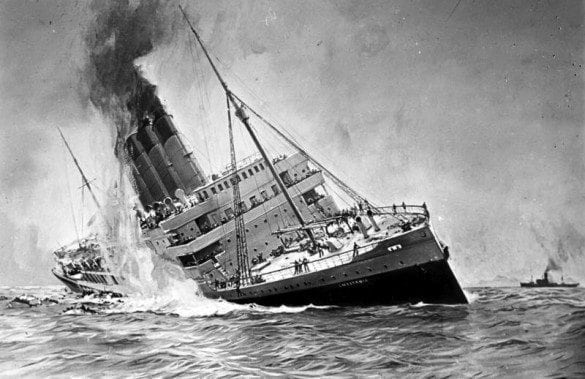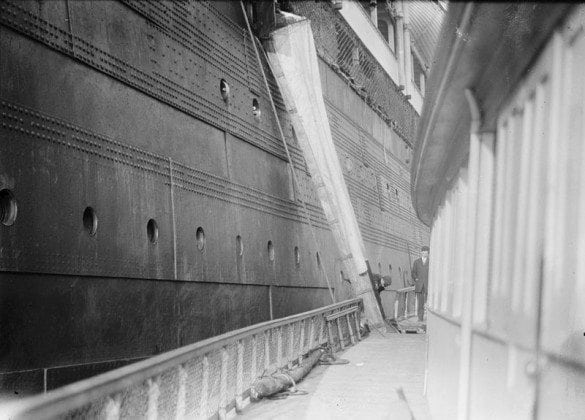
When it comes to the nautical world, Ireland is probably best known as being the birthplace of the Titanic. If you didn’t already know, it was built at the Harland and Wolff shipyards in Belfast (hence why the city now has a massive museum dedicated to the ill-fated boat) and the last stop before it set off into the Atlantic was at Cobh in county Cork. However, a second doomed vessel also has a strong link to the Emerald Isle; the RMS Lusitania sank off the coast of Kinsale (also in Cork) just three years after the Titanic met its tragic end.
Passenger Ships in the 1900s
The early 20th century was an exciting time for sea travel. Commercial airplanes had yet to take off (in more ways than one) but the richer members of society in Europe had developed a taste for travelling to foreign lands for pleasure. As well as that, cargo ships were regularly crossing the Atlantic and undertaking lengthy journeys in various directions to pick up goods and transport them to be sold in new markets.
This had been going on for quite some time already of course, but with the rapid advancement of engineering sea vessels were becoming bigger, more efficient, and better constructed. The industry exploded towards the end of the 19th century, and by the 1900s passenger boats were all the rage. With the trend for recreational travel soaring, there was intense competition between shipping companies, with each one trying to outdo the other with every step. In England, two of the leaders of the industry included the Blue Star Line and the White Star Line; the latter of which was responsible for the Titanic. There was also an American run company going by the name of Red Star Line.
The American/English run Cunard Line, still in existence today, was another major player. There were plenty of others too, and they all raced to create the biggest, best ship the world had ever seen (and make a fortune from passenger fares while they were at it). Passenger ships were run thanks to steam engines, and most of them were big beasts that crossed from the edge of Western Europe across to the United States and Canada every month.
Crossings took from between a few weeks to a month depending on the ship, and were usually crowded with American immigrants making a visit home or European emigrants setting off for a new life in the land of opportunity. Over time ships became more ornate on the inside with passengers divided according to the amount they paid for the ticket. First class passengers enjoyed gourmet meals and attentive staff, while third class passengers had no such luxuries. Nonetheless travel by ship was the only way for people to get to new and exotic lands, and was an unforgettable occasion for all.

History of the Lusitania
The Lusitania was commissioned by the Cunard Line along with a sister ship, the Mauretania, to compete with monster German ships that were taking to the waters. The process of financing and designing the ship began in 1903. It was decided early on that the ship would use turbine engines, which produced less vibration, used less fuel and allowed ships to operate at faster speeds (25 knots to be precise). It also included four funnels, four propellers, and a refined hull shape.
All machinery was below the waterline so that it was better protected from gunfire, with coal stores placed all around the edges to protect the interior for the same reason. There was also a whopping six levels of passenger accommodation - the norm was 4. When finished, it was briefly the largest ship ever built at 240m long and 50m high. It was capable of holding 50% more passengers than the next biggest ships at the time, with capacity for 2198 passengers and 827 staff.
The interior of the Lusitania was even more impressive than its mechanics, with extensive use of plasterwork, frescoes, gilt mahogany panelling and decorated corinthian columns. The furniture however was still bolted to the floor! In a similar vein to the Titanic, a grand stairway linked all 6 passenger desks with two wide hallways on each floor leading off it. While first and second class accommodation was equally if not more extravagant than other passenger ships, third class quarters were a step above the norm with wide open spaces, comfortable seating, and even a piano for entertainment.
The ship was built in John Brown shipyards in Clydebank, Scotland. The entire shipyard had to be reorganised to accommodate the building of the ship, and it had to be launched diagonally into the river Clyde since it was wider than the river itself! It was launched in June 1906 with much fanfare and after trials and final finishing touches, had its maiden voyage in September 1907. It was intended to be one of three ships that between them would make weekly crossings from Liverpool to New York, stopping off at Queenstown (now Cobh) along the way to pick up more passengers.
Over the next 8 years, the Lusitania made a total of 202 crossings of the North Altlantic. It was a record breaker, completing the journey in just 5 days and 54 minutes - and that was after delays from fog and the new engines being broken in. At New York thousands of people and hundreds of horse drawn cabs crowded at the shores to welcome the ship - every single police officer in the city was required to control the crowd!

When the Titanic sank in 1912, safety concerns were raised. The Lusitania only had a few more lifeboats than the Titanic, so 6 more wooden clinker boats were added, bringing the total to 48 - still not adequate. Navy experts held firm to the belief that on such on a busy crossing route, help would never be too far away. This changed however with the outbreak of World War 1; passenger numbers fell and cost cutting measures were introduced.
The ship was painted in drab grey colours to make it less visible, and the threat of submarines and mines was rife. There were guarantees in place from all sides that civilian ships would not be attacked provided they allowed soldiers to board and search the vessel, only flew its own flag and did not pretend to be of any other nationality. It was business as usual for the Lusitania.
Sinking of the Lusitania
In 1915 Germany stepped up its game in the war, increasing the amount of submarines and U-boats and, significantly, declaring the waters around the UK and Ireland a war zone. Any Allied ships found in the area would be sunk without warning. Two navy ships were ordered to escort the Lusitania when it entered the exclusion zone, but the captain refused to give out his coordinates as a precautionary measure (he had no way of knowing if they were telling the truth or if it was an attempt at sabotage). He also took down all flags, directly violating the ‘Cruiser Rules’ that offered passenger ships wartime protection.
A warning was placed beside all advertisements for Lusitania crossings warning potential passengers of the dangers of sailing through the exclusion zone, Still, the ship kept going. On 7th May 1915 the Lusitania was nearing the end of her 202nd voyage, on the way back to Liverpool from New York. It was carrying 1266 passengers and 696 crew (a total of 1,962 people on board). It was sailing alongside the southern coast of Ireland, around 11 miles away from the Old Head of Kinsale at its usual fast pace. It happened to intersect with a German U-boat, which fired one torpedo towards its starboard bow, making impact just underneath the wheelhouse.
Seconds later an explosion in the hull erupted and the whole boat listed violently to the side. Although the crew immediately began an evacuation procedure, the boat was listing with such force that most of lifeboats were too high to be lowered into the sea; only 6 of the 48 were launched successfully; most of the others capsized. Eighteen minutes after the ship was hit, it was fully submerged. Irish rescuers launched into action and managed to save some 764 of the 1,962 passengers; most of the victims died from either drowning or hypothermia before the rescuers could reach them.
A British cruiser also left from a nearby Cork harbour, but was ordered to turn back in case of further attack, adding to the loss of lives. There was international outcry at the sinking, which the Allied forces claimed was a totally unnecessary attack on innocent civilians. It soon emerged however that the Lusitania was in fact secretly carrying ‘contraband of war’ on the order of the British government. This combined with the fact that it was sailing in a declared war zone made it a perfectly reasonably target, the Germans claimed.
The British were especially outraged and urged America to join the war with them, since 128 American citizens on board the ship lost their lives. It was another 18 months before America finally gave in and joined the war effort however.

The wreck of the Lusitania still lies on the sea bed just off the coast of Kinsale, and is officially owned by Gregg Bemis. Bemis has spent years battling courts in Ireland, the UK and the US to ensure his ownership of the vessel is secure, and has spent millions photographing, examining and recovering artefacts from the wreck.
Among plenty of other objects said to be on the ship at the time of sinking are several extremely valuable paintings in lead tubes which art collector Hugh Lane was transporting. Among the collection were works by Monet, Rembrandt and Rubens. Although there has been much debate over who the recovered artefacts should belong to, some of them have eventually made their way to Ireland’s museums.
